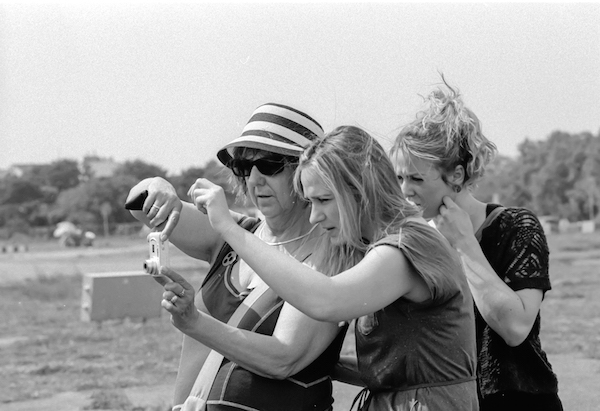A blog post I published here earlier this month got such an intriguing comment from a blogger in Germany that I asked her to write a guest post here. She said “Ja!”
Photo Narrations — pictures for the blind and sighted
by Tina Paulick
Beth’s post was about how she asked writers in her memoir writing class to describe a photograph to someone who is blind and the amazing texts resulting from this exercise. Our blog Photo Narrations for the blind and sighted is dedicated to describing photographs taken by photographers who are visually impaired or blind. It is a great place for blind and sighted photographers and creative writers to:
- reflect on photographs
- gain a better understanding of the process of seeing and perceiving
- respect photography and photo narration as art forms

Two sighted students help a blind photographer adjust her camera to take a picture in Berlin. (Photo credit: Stephan Wilke)
If you are wondering now why blind people are interested in something so visual as photography, our blog also features interviews and guest posts by blind photographers explaining their motivations and how they work. One of our contributors writes:
People always ask, why do blind people want to take photos. I always get this question and it frustrates me, so why don’t we give them an answer. Because we want to, because we can! Why do you take photographs? The world is full of images, we are surrounded by them. Obviously they are important. But blind people cannot see them in the same way sighted people do. We see with sound, touch and our imagination. That’s why photo narration is so important to us. The photo narration helps to capture the image we ultimately see in our minds.
Our sighted describers also benefit from the experience – writing photo narrations for blind people expands one’s perception and imagined boundaries. Karsten Hein, a sighted photographer from Germany who initiated this project writes:
For me as a sighted person, interested in pictures and the perception of pictures, it is a remarkable experience to describe pictures for blind people. It’s a completely different thing, when I look at a photograph in order to describe it for someone, who cannot see it. I have to think in a completely different way than I normally would. What’s important in the photograph? What’s worth mentioning? I look closer and closer, closer than I would look at it in nearly any other context. And the more I look at it the more I have to come to understand how little I really know about the photograph.
Karsten’s idea for this project came after he did a portrait series featuring people who are blind. He talked to his models during the shootings so they’d forget the camera and feel more comfortable. The models had many questions about what impact their appearance might make on other people, and they expressed an interest in photography. Thus, Karsten developed photography workshops for visually impaired and blind photographers.
Karsten’s classes are run in cooperation with a University in Berlin. A small team of sighted students is allocated to every photographer to help him or her to find motives, adjust the camera ,select the best picture and describe the resulting photo in text. We set up our German blog Bilder für die Blinden to showcase the work.
Now we’ve started an English Photo Narrations blog, too, to spread our idea further and to encourage people all over the world to become part of our creative community. We are always looking for volunteers to write descriptions of photographs for us. As Beth pointed out in her Describing a photograph to someone who can’t see blog post, it’s a great creative writing exercise.
Additionally, we provide a platform to publish and discuss the narrations writers come up with for the photographs — our blind and visually impaired members can write comments and ask further questions.
Back to me — I may just give this a try! I don’t think I’ll take any photos, but I may send some photos people give me to the photo narrations blog to see how they describe what’s going on there. Take a look at — or a listen to — the Photo Narrations blog for further information or contact them at: picdesc@gmail.com
You can like them on Facebook or follow them on twitter at @PicDesc, too.
Great minds think alike. In this case, great minds connected across the ocean.
Oui!
_____
Are you familiar with this film?
http://www.imdb.com/title/tt0102721/
Nope. Should I be?!
_____
Oh. The movie, Proof! I remember when it came out, but I’ve always shied away from movies with characters who are blind.
Blind characters tend to be portrayed one-dimensionally – we’re either heroic or tragic, bumbling or, particularly lately, blessed with super-powers.
But that said, I used to shy away from web sites about outlandish things like blind photography, and her I am. Once baseball season is over and we start watching movies again, I’ll put Proof! on our list.
_____
Leave a Response